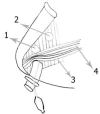Submental intubation in maxillofacial trauma patients
- PMID: 24303414
- PMCID: PMC3846236
Submental intubation in maxillofacial trauma patients
Abstract
Introduction: To describe a modified technique for submental intubation in severely traumatized maxillofacial patients and to evaluate complications arising from the procedure.
Materials and methods: Submental intubation was performed in twelve patients with maxillofacial trauma ,from 2007-2012, which were operated under general anesthesia for treatment of facial fractures.
Results: The patients ranged in age from 14 to 39 years. No complications due to submental intubation, such as infection, hypertrophic scarring, lingual nerve injury, hematoma, bleeding, ranula formation, or orocutaneous fistula, were observed following submental intubation.
Conclusion: Submental intubation is a very useful technique in the management of maxillofacial trauma patients, with a low complication rate.
Keywords: Intubation; Jaw fracture; Submental.
Figures




References
-
- Taher AA. Nasotracheal intubation in patients with facial fractures. Plast Reconstr Surg. 1992;90(6):1119–20. - PubMed
-
- Gibbons AJ, Hope DA, Silvester KC. Oral endotracheal intubation in the management of midfacial fractures. Br J Oral Maxillofac Surg. 2003;41(4):259–60. No abstract available. - PubMed
-
- Schütz P, Hamed HH. Submental intubation versus tracheostomy in maxillofacial trauma patients. J Oral Maxillofac Surg. 2008;66(7):1404–9. - PubMed
LinkOut - more resources
Full Text Sources
